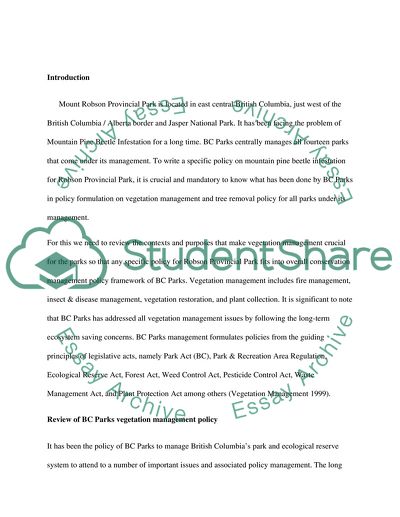Cite this document
(“The Mountain Pine Beetle Infestation in Robson Provincial Park Research Paper”, n.d.)
Retrieved from https://studentshare.org/environmental-studies/1553339-review-the-bc-parks-vegetation-management-policy-and-the-tree-removal-policy-and-related-conservation-management-policies-in-order-to-write-a-specific-management-policy-addressing-the-mountain-pine-beetle-infestation-in-robson-provincial-parkmore-info
Retrieved from https://studentshare.org/environmental-studies/1553339-review-the-bc-parks-vegetation-management-policy-and-the-tree-removal-policy-and-related-conservation-management-policies-in-order-to-write-a-specific-management-policy-addressing-the-mountain-pine-beetle-infestation-in-robson-provincial-parkmore-info
(The Mountain Pine Beetle Infestation in Robson Provincial Park Research Paper)
https://studentshare.org/environmental-studies/1553339-review-the-bc-parks-vegetation-management-policy-and-the-tree-removal-policy-and-related-conservation-management-policies-in-order-to-write-a-specific-management-policy-addressing-the-mountain-pine-beetle-infestation-in-robson-provincial-parkmore-info.
https://studentshare.org/environmental-studies/1553339-review-the-bc-parks-vegetation-management-policy-and-the-tree-removal-policy-and-related-conservation-management-policies-in-order-to-write-a-specific-management-policy-addressing-the-mountain-pine-beetle-infestation-in-robson-provincial-parkmore-info.
“The Mountain Pine Beetle Infestation in Robson Provincial Park Research Paper”, n.d. https://studentshare.org/environmental-studies/1553339-review-the-bc-parks-vegetation-management-policy-and-the-tree-removal-policy-and-related-conservation-management-policies-in-order-to-write-a-specific-management-policy-addressing-the-mountain-pine-beetle-infestation-in-robson-provincial-parkmore-info.


